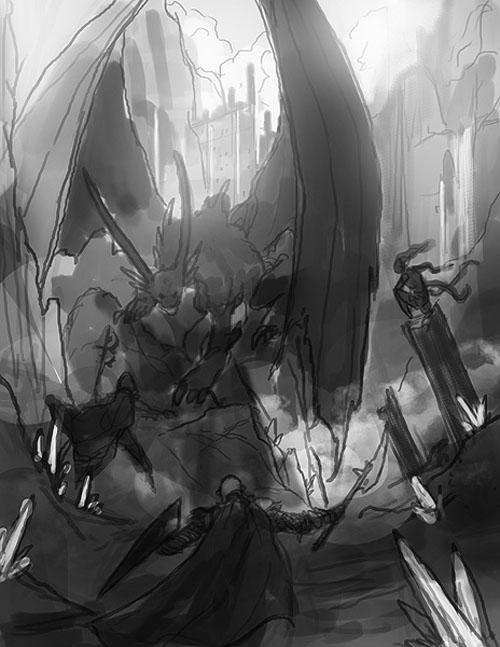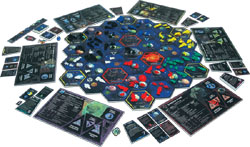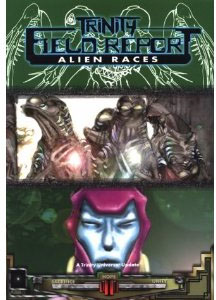The ocular tyrant is a bulbous ball of floating flesh dominated by a large, central eye which protrudes from its circular bulk. Five smaller eyes extend on thickly-veined eyestalks in a penumbral crown above it, while a dangling array of five psychic tendrils hang in a thick mass below it.
DESIGN NOTES
The first goal of the ocular tyrant is to provide an OGL alternative to a well-known beastie that remains unavailable because it was declared product identity. Their progenitor is fairly self-evident, and the ocular tyrants are happy to become part of that proud family which includes luminaries like the gazers from Ultima. (Or, at least, as happy as these cynical, narcissistic creatures can ever be.) The main innovation here are the psychic tendrils, which initially occurred to me as a lark and are now growing on me quite a bit.
The second goal was to tweak the power list of the progenitor to improve it. Whether you use the original creature or the ocular tyrant, I hope you’ll give some thought to swapping in the power list below. Let me explain why.
Original List of Eyes: charm monster, charm person, disintegrate, fear, finger of death, flesh to stone, inflict moderate wounds, sleep, slow, telekinesis
This list presents three problems.
First, duplicate powers. Does it really need both charm person and charm monster? Similarly, although disintegrate was revised in 3.5 to resolve a little differently, both it and finger of death are basically slightly different ways of saying “save or die”. Speaking of which…
Second, two of its powers are type 4 save-or-die effects (save or you’re dead); four are type 3 (save or you’re out of the encounter); and one is a type 2. I don’t necessarily think all save-or-die effects need to be nerfed out of existence, but the massive lethality of seven save-or-you’re-gone abilities being unleashed every round has certainly made me hesitant about using these guys over the years.
The other problem is that these save-or-die abilities make the ocular tyrant too dangerous. The only way to make the creature at all workable is to nerf its hit points so that the PCs can take it out quickly. But the result turns it into a super-swingy paper tiger: PCs who get the drop on it will often wipe it out before it can even take a shot. PCs who don’t are likely to be completely devastated. There’s no way to have any kind of substantial confrontation with the monster the way that it’s currently designed.
Third, because sleep has been nerfed so many times over the years it’s now effectively useless to the creature: It’s a CR 13 creature, but sleep isn’t effective against any creature with more than 4 HD.
Some of this stuff just has to go.
The Culling: charm monster, —, disintegrate, fear, —, flesh to stone, inflict moderate wounds, greater sleep, slow, telekinesis
This list eliminates the duplicates and bumps sleep up into being an effect that will actually be meaningful in CR-appropriate encounters (see below).
The next thing I’m going to do is take the two severe save-or-die effects (disintegrate, flesh to stone) and modify them: I don’t want to eliminate these effects from the tyrant’s arsenal, but I will soften them up a bit so that I can use ’em with heartless glee as a DM.
Finally, I need to replace the two abilities I removed entirely.
The Replacements: confusion, force missile
Confusion feels like a good replacement for charm person: It’s got a similar role in combat (turning friends on friends), but does it in a unique way that doesn’t duplicate charm monster.
Force missile is an original spell I developed a couple years back. It’s similar to magic missile, but it’s going to give the ocular tyrant the ability to shove people around the battlefield. I think it’ll complement telekinesis and really let this guy throw his weight around.
THE NEW SPELLS
These are the new spells I’m using.
SLEEP, GREATER
Enchantment (Compulsion) [Mind-Affecting]
Level: Bard 3, Sorcerer/Wizard 3
Components: V, S, M
Casting Time: Standard Action
Range: Medium (100 ft. + 10 ft./level)
Area: Several living creatures within a 15-foot-radius burst
Duration: 1 minute/level
Saving Throw: Will negates
Spell Resistance: Yes
As sleep, except that you roll 4d6 to see how many Hit Dice of creatures are affected.
FORCE MISSILE
Evocation [Force]
Level: Sorcerer/Wizard 3
Components: V, S, M
Casting Time: 1 standard action
Range: Medium (100 ft. + 10 ft./level)
Targets: Up to 5 creatures, no two of which can be more than 15 ft. apart
Duration: Instantaneous
Saving Throw: Fortitude partial (see text)
Spell Resistance: Yes
Force missile is similar to magic missile, but each missile inflicts 1d6+1 points of force damage. In addition, a target struck by a force missile must make a Fortitude save or be forced back 5 feet per 3 caster levels. (So a creature struck by a 6th-level caster would be forced back 10 feet.) Forced movement is in a straight line directly away from the caster.
THE OCULAR TYRANT
OCULAR TYRANT (CR 12+1*): 152 hp (16d8+80), AC 23, ranged touch +21 (eyestalks), Save +15, Ability DC 21, Size Large
Str 10, Dex 14, Con 18, Int 18, Wis 15, Cha 14
All-Around Vision immune to flanking
Darkvision 60 ft.
Fly 20 ft. (perfect)
Antimagic Eye (Su): The ocular tyrant’s main eye emits a continual 160-ft. cone in which magic items, spells, spell-like abilities, and supernatural abilities (including the tyrant’s eyestalks and psychic tendrils) have no effect. Spells or effects brought within the area are suppressed, but not dispelled. Summoned creatures and incorporeal undead wink out of existence within the area, but reappear in the same spot when the tyrant’s gaze moves away. (Time spent within the area counts against the suppressed spell’s or summoned creature’s duration.) The ocular tyrant can redirect the gaze of its main eye as an immediate action.
Eyestalks (Sp): As a full action, the ocular tyrant can fire any number or combination of its eyestalks and psychic tendrils. The tyrant’s eyestalks require successful ranged touch attacks (unless otherwise noted below). The maximum range is 160 ft. The effective caster level is 11th.
Disintegrating Ray: A thin, green ray which inflicts 2d6 points of Constitution damage (or 5d6 hit points on a successful Fortitude save). If this damage kills the target, it is entirely disintegrated. When used against an object, the ray simply distintegrates up to one 10-foot cube of nonliving matter. The ray even affects objects constructed entirely of force energy.
Flesh to Stone: A dull gray ray which inflicts 2d6 points of Dexterity damage (Fortitude save negates). If this damage reduces the target’s Dexterity to 0, the target, along with all its carried gear, is turned into a mindless, inert statue.
Inflict Moderate Wounds: A black ray coruscated with silver, inflicting 2d8+11 points of damage.
Force Missiles: The eye emits five missiles of force energy, which can be directed independently at multiple targets. Each missile unerringly strikes its target and inflicts 1d6+1 points of force damage. In addition, a target struck by one or more force missiles must make a Fortitude save or be forced back 15 ft. directly away from the ocular tyrant. (This movement does not provoke attacks of opportunity.)
Slow: An orange-red ray which drastically slows the target (Will save negates). The victim moves at half speed, can only take a single standard action each turn, and suffers a -1 penalty to attack rolls, AC, and Reflex saves.
Psychic Tendrils (Sp): The ocular tyrant can fire any number or combination of its eyestalks and psychic tendrils as a full action. Each psychic eyestalk affects a single target (unless otherwise noted below). The maximum range is 160 ft. The effective caster level is 11th.
Charm Monster: The target considers the ocular tyrant to be its trusted friend and ally. The charm effect lasts for 11 days. (Will save negates; +5 bonus on the saving throw if the ocular tyrant is currently attacking the target or its allies.)
Confusion: The target becomes confused for 11 rounds (Will save negates).
Fear: The target must make a Will save or become panicked for 11 rounds. On a successful save, they are shaken for 1 round.
Greater Sleep: This psychic tendril causes 4d6 HD of creatures to fall unconscious for 11 minutes (Will negates). It can affect multiple creatures within range, with those closest to the ocular tyrant succumbing to the effect first. Wounding a sleeping creature awakens them, but normal noise does not. Allies can use a standard action to slap a victim awake.
Telekinesis: Using this tendril, the ocular tyrant can apply a sustained force (moving objects weighing 275 pounds or less up to 20 feet per round; creatures can negate the effect on an object it possesses with a Will save), perform a combat maneuver (bull rush, disarm, grapple, or trip without provoking attacks of opportunity, using a +14 bonus for any required action checks), or make a violent thrust. During a violent thrust, the tyrant can hurl up to 11 objects or creatures (all within 10 feet of each other and weighing no more than a total of 275 pounds) towards any target within 10 feet of the objects. The tyrant makes an attack roll for each object, dealing 1 point of damage per 25 pounds (for less dangerous objects) or 1d6 points of damage per 25 pounds (for hard, dense objects). Hurled creatures and creatures holding hurled objects get a Will save to negate the effect.
* CR adjustment due to multiple attacks each round.
FINAL NOTES
The stat block here is designed for Legends & Labyrinths, but can be used in 3.5 without modification. (That’s the whole point of L&L, after all.) Alternatively you can just grab the eyestalks and psychic tendrils and slap ’em onto the stat block in the MM.
This material is covered under the Open Game License.
















